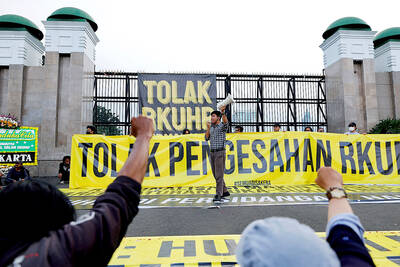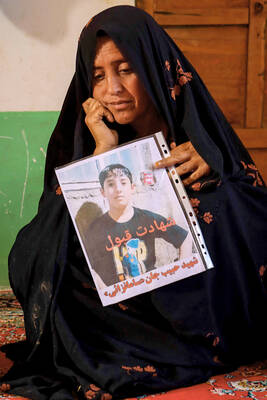Waters from last year’s floods in Australia’s southeast are gushing out to sea and taking carp with them — but the salinity of the ocean is killing the invasive species, so dead fish are now washing up on South Australian beaches.
Pictures from Middleton, Port Elliot and Goolwa show piles of juvenile carp littering the shores of the popular summer destinations.
The principal biosecurity officer for weeds and pests at the state’s Department of Primary Industries and Regions said it was normal for carp to spawn at this time of year, but that the high flows were flushing them from the fresh water of the River Murray into the marine environment.
“They’re normally tolerant [of different environments], but don’t take high salinity well ... that’s why we’re seeing fish deaths,” she said.
“Normally when there’s a fish kill event, the fish will be either consumed by other species or degrade and form part of the natural system,” she said. “We do still expect them to be washed back in over days and weeks.”
If the piles of rotting fish do accumulate, though, she said there is a plan to bring in contractors to remove them in a sustainable way, possibly through composting.
On Facebook, John Cork-Gorringe wrote there were mulloway and bream at Middleton as well.
“The shallows are alive with carp struggling in the salty water,” he wrote. “I will never see this again in my lifetime.”
Rodgers said the dead fish were mostly carp, which have invaded Australia’s rivers in enormous numbers.
In 2016, then-water minister Barnaby Joyce announced a plan to introduce the herpes virus into the carp population to control their numbers.
However, when the National Carp Control Plan was released at the end of the year, it recommended more research be done.
Carp have since been spawning in huge numbers, particularly after the floods.
A group of Charles Sturt University ecologists this week said the “videos of writhing masses of both adult and young fish illustrate that all is not well in our rivers.”
They described the “house of horrors” the carp cause as they degrade plants and habitats.
“They can make the bed of many rivers look like the surface of golf balls — denuded and dimpled, devoid of any habitat,” they said in the Conversation.
They said the previous estimate of up to 357 million fish in Australia’s rivers and wetlands could be exceeded this year.
“Carp are super-abundant right now, because floods give them access to floodplain habitats,” the ecologists said. “There, each large female can spawn millions of eggs and the young have high survival rates.”
It is a boom year because of the flooding and the spike in numbers has prompted calls for a release of the herpes virus.

Indonesia yesterday began enforcing its newly ratified penal code, replacing a Dutch-era criminal law that had governed the country for more than 80 years and marking a major shift in its legal landscape. Since proclaiming independence in 1945, the Southeast Asian country had continued to operate under a colonial framework widely criticized as outdated and misaligned with Indonesia’s social values. Efforts to revise the code stalled for decades as lawmakers debated how to balance human rights, religious norms and local traditions in the world’s most populous Muslim-majority nation. The 345-page Indonesian Penal Code, known as the KUHP, was passed in 2022. It

‘DISRESPECTFUL’: Katie Miller, the wife of Trump’s most influential adviser, drew ire by posting an image of Greenland in the colors of the US flag, captioning it ‘SOON’ US President Donald Trump on Sunday doubled down on his claim that Greenland should become part of the US, despite calls by the Danish prime minister to stop “threatening” the territory. Washington’s military intervention in Venezuela has reignited fears for Greenland, which Trump has repeatedly said he wants to annex, given its strategic location in the arctic. While aboard Air Force One en route to Washington, Trump reiterated the goal. “We need Greenland from the standpoint of national security, and Denmark is not going to be able to do it,” he said in response to a reporter’s question. “We’ll worry about Greenland in

PERILOUS JOURNEY: Over just a matter of days last month, about 1,600 Afghans who were at risk of perishing due to the cold weather were rescued in the mountains Habibullah set off from his home in western Afghanistan determined to find work in Iran, only for the 15-year-old to freeze to death while walking across the mountainous frontier. “He was forced to go, to bring food for the family,” his mother, Mah Jan, said at her mud home in Ghunjan village. “We have no food to eat, we have no clothes to wear. The house in which I live has no electricity, no water. I have no proper window, nothing to burn for heating,” she added, clutching a photograph of her son. Habibullah was one of at least 18 migrants who died

Russia early yesterday bombarded Ukraine, killing two people in the Kyiv region, authorities said on the eve of a diplomatic summit in France. A nationwide siren was issued just after midnight, while Ukraine’s military said air defenses were operating in several places. In the capital, a private medical facility caught fire as a result of the Russian strikes, killing one person and wounding three others, the State Emergency Service of Kyiv said. It released images of rescuers removing people on stretchers from a gutted building. Another pre-dawn attack on the neighboring city of Fastiv killed one man in his 70s, Kyiv Governor Mykola